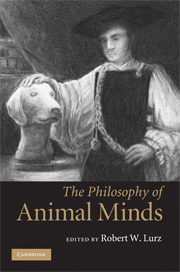Book contents
- Frontmatter
- Contents
- List of contributors
- Acknowledgments
- The philosophy of animal minds: an introduction
- 1 What do animals think?
- 2 Attributing mental representations to animals
- 3 Chrysippus' dog as a case study in non-linguistic cognition
- 4 Systematicity and intentional realism in honeybee navigation
- 5 Invertebrate concepts confront the generality constraint (and win)
- 6 A language of baboon thought?
- 7 Animal communication and neo-expressivism
- 8 Mindreading in the animal kingdom
- 9 The representational basis of brute metacognition: a proposal
- 10 Animals, consciousness, and I-thoughts
- 11 Self-awareness in animals
- 12 The sophistication of non-human emotion
- 13 Parsimony and models of animal minds
- 14 The primate mindreading controversy: a case study in simplicity and methodology in animal psychology
- Glossary of key terms
- References
- Index
4 - Systematicity and intentional realism in honeybee navigation
Published online by Cambridge University Press: 05 June 2012
- Frontmatter
- Contents
- List of contributors
- Acknowledgments
- The philosophy of animal minds: an introduction
- 1 What do animals think?
- 2 Attributing mental representations to animals
- 3 Chrysippus' dog as a case study in non-linguistic cognition
- 4 Systematicity and intentional realism in honeybee navigation
- 5 Invertebrate concepts confront the generality constraint (and win)
- 6 A language of baboon thought?
- 7 Animal communication and neo-expressivism
- 8 Mindreading in the animal kingdom
- 9 The representational basis of brute metacognition: a proposal
- 10 Animals, consciousness, and I-thoughts
- 11 Self-awareness in animals
- 12 The sophistication of non-human emotion
- 13 Parsimony and models of animal minds
- 14 The primate mindreading controversy: a case study in simplicity and methodology in animal psychology
- Glossary of key terms
- References
- Index
Summary
INTRODUCTION
Do animals really have intentional states, or is intentional ascription merely a convenient instrument for predicting their behavior that involves no commitment to the reality of those states? One way to give substance to this question is to consider the recent debate between “classical” and “radical connectionist” approaches to cerebral architecture. According to the classical, realist theory of cognition, championed by Fodor (1975, 1987), cognitive processes consist of computations defined over causally efficacious, syntactically specified representations, for example sentences in a “language of thought,” whose syntactic structure preserves the content of those representations compositionally: representations are either simple or complex, the complex ones being composed by concatenation of the simple ones in such a way that the semantic properties of the complex are a function of the semantic properties of the simple. The main rival to classicism is (non-implementational, or “radical,” “distributed”) connectionism, which proposes instead that cognitive processes are computations defined over syntactically simple, distributed representations, for which the constituency relation is certainly not concatenative, nor standardly compositional. Indeed, in contrast to classical machine architectures, connectionist architectures standardly do not make available to an organism recombinable representations that might be stored in memory and deployed at different times for different tasks. This air of unreality about internal representations can lend support to the aforementioned instrumentalism, as in Dennett (1987, 1991a).
- Type
- Chapter
- Information
- The Philosophy of Animal Minds , pp. 72 - 88Publisher: Cambridge University PressPrint publication year: 2009
- 9
- Cited by

